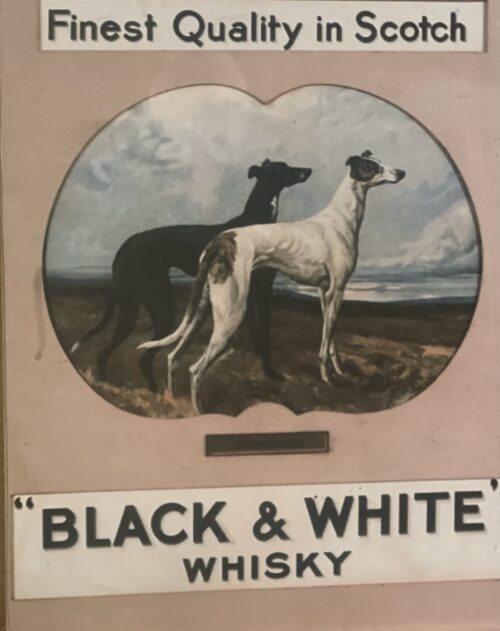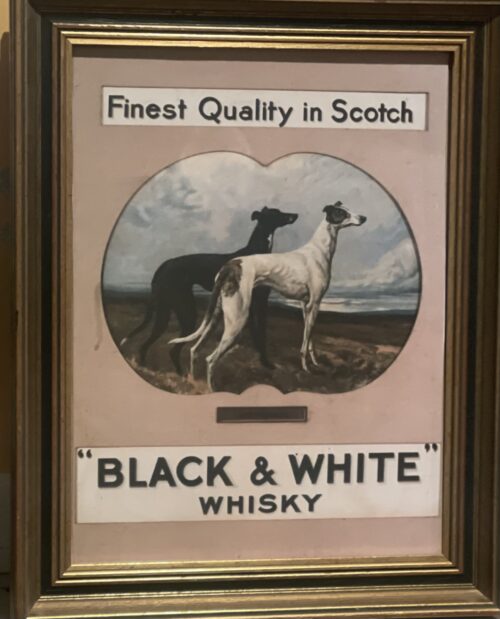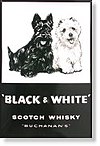Classy advert depicting the magnificence of Dunluce Castle ,just down the road from the famed Bushmills Distillery.
Portrush Co Antrim 52cm x 72cm
In the 13th century,
Richard Óg de Burgh, 2nd Earl of Ulster, built the first castle at Dunluce.
It is first documented in the hands of the
McQuillan family in 1513. The earliest features of the castle are two large
drum towers about 9 metres (30 ft) in diameter on the eastern side, both relics of a stronghold built here by the McQuillans after they became lords of
the Route.
The McQuillans were the Lords of Route from the late 13th century until they were displaced by the MacDonnell after losing two major battles against them during the mid- and late-16th century.

The castle in the last decade of the 19th century
Later Dunluce Castle became the home of the chief of the
Clan MacDonnell of Antrim and the
Clan MacDonald of Dunnyveg from
Scotland. Chief John Mor MacDonald was the second son of
Good John of Islay, Lord of the Isles, 6th chief of
Clan Donald in Scotland. John Mor MacDonald l was born through John of Islay's second marriage to Princess Margaret Stewart, daughter of King
Robert II of Scotland. In 1584, on the death of James MacDonald the 6th chief of the Clan MacDonald of Antrim and Dunnyveg, the Antrim Glens were seized by
Sorley Boy MacDonnell, one of his younger brothers. Sorley Boy took the castle, keeping it for himself and improving it in the Scottish style. Sorley Boy swore allegiance to
Queen Elizabeth I and his son Randal was made
1st Earl of Antrim by
King James I.
Four years later, the
Girona, a
galleass from the
Spanish Armada, was wrecked in a storm on the rocks nearby. The
cannons from the ship were installed in the
gatehouses and the rest of the cargo sold, the funds being used to restore the castle. MacDonnell's granddaughter Rose was born in the castle in 1613.
A local legend states that at one point, part of the kitchen next to the cliff face collapsed into the sea, after which the wife of the owner refused to live in the castle any longer. According to a legend, when the kitchen fell into the sea, only a kitchen boy survived, as he was sitting in the corner of the kitchen which did not collapse. However, the kitchen is still intact and next to the manor house. You can still see the oven, fireplace and entry ways into it. It wasn't until some time in the 18th century that the north wall of the residence building collapsed into the sea. The east, west and south walls still stand.
Dunluce Castle served as the seat of the
Earl of Antrim until the impoverishment of the MacDonnells in 1690, following the
Battle of the Boyne. Since that time, the castle has deteriorated and parts were scavenged to serve as materials for nearby buildings.
Dunluce town
In 2011, major archaeological excavations found significant remains of the "lost town of Dunluce", which was razed to the ground in the
Irish uprising of 1641.
Lying adjacent to Dunluce Castle, the town was built around 1608 by
Randall MacDonnell, the first
Earl of Antrim, and pre-dates the official
Plantation of Ulster.
It may have contained the most revolutionary housing in Europe when it was built in the early 17th century, including indoor toilets which had only started to be introduced around Europe at the time, and a complex street network based on a grid system.
95% of the town is still to be discovered.
Cultural references
- The castle inspired the orchestral tone poem Dunluce (1921) by Irish composer Norman Hay.
- Dunluce Castle is thought to be the inspiration for Cair Paravel in C. S. Lewis's Chronicles of Narnia (1950–54).
- Ron Moody menaced Jack Wild and Helen Raye at Dunluce Castle in Flight of the Doves, a 1971 film.
- In 1973 the castle appeared on the inner gatefold of the multi-million selling Led Zeppelin album Houses of the Holy.
- On the 1984 Gary Moore video "Emerald Aisles" on his return to Northern Ireland, he visits the castle and talks about the history of the castle. Cassette and CD versions of Gary Moore's 1989 album After the War feature an instrumental track titled "Dunluce" in one and two parts respectively.
- The castle is also the subject of a 1990s song named "Dunluce Castle" written by George Millar and sung by the Irish Rovers.
- The castle is mentioned and appears briefly in Michael Palin's 1994 episode of Great Railway Journeys, Derry to Kerry.
- The castle appeared as Snakehead's hideout under the name 'Ravens Keep' in the 2003 movie, The Medallion, which starred Jackie Chan.
- It is also featured on the cover of the album Glasgow Friday (2008) by American musician Jandek.
- The castle is the film location of the Game of Thrones Seat of House Greyjoy, the great castle of Pyke.The Old Bushmills Distillery is a distillery in Bushmills, County Antrim, Northern Ireland, owned by Casa Cuervo of Mexico. Bushmills Distillery uses water drawn from Saint Columb's Rill, which is a tributary of the River Bush. The distillery is a popular tourist attraction, with around 120,000 visitors per year.
The company that originally built the distillery was formed in 1784, although the date 1608 is printed on the label of the brand – referring to an earlier date when a royal licence was granted to a local landowner to distil whiskey in the area.
After various periods of closure in its subsequent history, the distillery has been in continuous operation since it was rebuilt after a fire in 1885.
The area has a long tradition with distillation. According to one story, as far back as 1276, an early settler called Sir Robert Savage of
Ards, before defeating the Irish in battle, fortified his troops with "a mighty drop of acqua vitae".
In 1608, a licence was granted to Sir
Thomas Phillips by
King James I to distil whiskey.
for the next seven years, within the countie of Colrane, otherwise called O Cahanes countrey, or within the territorie called Rowte, in Co. Antrim, by himselfe or his servauntes, to make, drawe, and distil such and soe great quantities of aquavite, usquabagh and aqua composita, as he or his assignes shall thinke fitt; and the same to sell, vent, and dispose of to any persons, yeeldinge yerelie the somme 13s 4d ...
The Bushmills Old Distillery Company itself was not established until 1784 by Hugh Anderson.
Bushmills suffered many lean years with numerous periods of closure with no record of the distillery being in operation in the official records both in 1802 and in 1822. In 1860 a Belfast spirit merchant named Jame McColgan and Patrick Corrigan bought the distillery; in 1880 they formed a limited company. In 1885, the original Bushmills buildings were destroyed by fire but the distillery was swiftly rebuilt. In 1890, a steamship owned and operated by the distillery, SS
Bushmills, made its maiden voyage across the Atlantic to deliver Bushmills whiskey to America. It called at
Philadelphia and
New York City before heading on to
Singapore,
Hong Kong,
Shanghai and
Yokohama.

A showcase at the distillery
In the early 20th century, the U.S. was a very important market for Bushmills (and other
Irish Whiskey producers). American
Prohibition in 1920 came as a large blow to the Irish Whiskey industry, but Bushmills managed to survive. Wilson Boyd, Bushmills' director at the time, predicted the end of prohibition and had large stores of whiskey ready to export. After the Second World War, the distillery was bought by
Isaac Wolfson, and, in 1972, it was taken over by
Irish Distillers, meaning that Irish Distillers controlled the production of all Irish whiskey at the time. In June 1988, Irish Distillers was bought by French liquor group
Pernod Ricard.
In June 2005, the distillery was bought by
Diageo for £200 million. Diageo have also announced a large advertising campaign in order to regain a market share for Bushmills.
In May 2008, the
Bank of Ireland issued a new series of
sterling banknotes in Northern Ireland which all feature an illustration of the Old Bushmills Distillery on the obverse side, replacing the previous notes series which depicted
Queen's University of Belfast.
In November 2014 it was announced that Diageo had traded the Bushmills brand with
Jose Cuervo in exchange for the 50% of the
Don Julio brand of
tequila that Diageo did not already own.














 Coursing operates in a highly regulated environment coupled with comprehensive rules directly applied by the ICC. It operates under a licence from the Minister of Arts, Heritage & the Gaeltacht, issued annually with a total of 22 conditions attached. Although our sport may take place only over the winter months and is sensitive to the hare breeding season, the protection and policing of preserves is a continuous activity and conducted on a voluntary basis. Quercus, the Belfast University research body reports that “Irish hares are 18 times more abundant in areas managed by the Irish Coursing Club than at similar sites in the wider countryside”.
Without regulated coursing there would be an increase of unregulated illegal hunting taking place throughout the year, with no organisation taking responsibility or interest in the overall well-being of the hare. If coursing clubs ceased to perform their functions, the hare population here would decline at a rapid rate as the proliferation of illegal hunting could easily rise to epidemic proportions as seen in the UK, where poaching and hare population decline are the order of the day.
Finally, I offer a quote I recently found that seems appropriate: “The future of coursing is so dependent on hare preservation that no effort should be spared by us to put it on an assured basis.”That was from an October 1924 edition of the Irish Coursing Calendar, now known as the Sporting Press newspaper.
The Irish Coursing Club has been, and will continue to be, deeply immersed in the conservation of the Irish Hare population, always seeking new ways to improve conservation in the face of loss of habitat due to the “advances” of our modern world and in spite of grossly uninformed efforts to ban it when no proven alternative conservation programmes are in place.
Coursing operates in a highly regulated environment coupled with comprehensive rules directly applied by the ICC. It operates under a licence from the Minister of Arts, Heritage & the Gaeltacht, issued annually with a total of 22 conditions attached. Although our sport may take place only over the winter months and is sensitive to the hare breeding season, the protection and policing of preserves is a continuous activity and conducted on a voluntary basis. Quercus, the Belfast University research body reports that “Irish hares are 18 times more abundant in areas managed by the Irish Coursing Club than at similar sites in the wider countryside”.
Without regulated coursing there would be an increase of unregulated illegal hunting taking place throughout the year, with no organisation taking responsibility or interest in the overall well-being of the hare. If coursing clubs ceased to perform their functions, the hare population here would decline at a rapid rate as the proliferation of illegal hunting could easily rise to epidemic proportions as seen in the UK, where poaching and hare population decline are the order of the day.
Finally, I offer a quote I recently found that seems appropriate: “The future of coursing is so dependent on hare preservation that no effort should be spared by us to put it on an assured basis.”That was from an October 1924 edition of the Irish Coursing Calendar, now known as the Sporting Press newspaper.
The Irish Coursing Club has been, and will continue to be, deeply immersed in the conservation of the Irish Hare population, always seeking new ways to improve conservation in the face of loss of habitat due to the “advances” of our modern world and in spite of grossly uninformed efforts to ban it when no proven alternative conservation programmes are in place.























